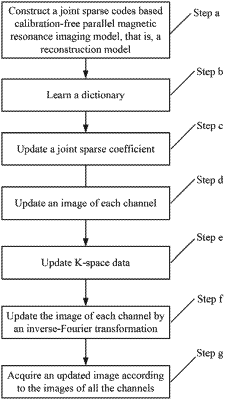| CPC G01R 33/5611 (2013.01) [G01R 33/5608 (2013.01); G06T 11/008 (2013.01); G06T 2207/10088 (2013.01); G06T 2207/20056 (2013.01); G06T 2207/20081 (2013.01)] | 18 Claims |

|
1. A parallel magnetic resonance imaging method based on adaptive joint sparse codes, applied by a parallel magnetic resonance imaging apparatus, comprising:
step a: constructing a calibration-free parallel magnetic resonance imaging model based on joint sparse codes, that is, a reconstructed model, wherein the model is defined as:
 wherein V denotes a reconstructed image, D∈cM×P denotes an overcomplete (P>>M) dictionary, θ denotes an objective function, X=(Xl,1|Xl,2 . . . Xl,j . . . ,|Xl,j)∈cp×j denotes a sparse matrix, Xl,j∈cP denotes an l-th extracted patch from a j-th channel image, FM denotes a Fourier transformation, vj denotes an image of each channel, V denotes a matrix formed by images vj of all channels, fj denotes K-space data, Rl∈cM×N denotes a patch extraction matrix, M denotes an atom size, N denotes a vectorized size of the image, P denotes a number of atoms, a subscript F denotes the Fourier transformation, λ denotes a data fitting term weight, β denotes a joint sparse regularization weight, and ∥Xl∥2,1 denotes a joint sparse term, and
wherein
 wherein Xlp,j2, denotes a p-th pixel for the l-th extracted patch from the j-th channel image;
step b: temporarily fixing X, and solving the dictionary D by using a gradient descent method:
 wherein γdenotes a learning rate, and k denotes a number of iterations, and
wherein
 applies, wherein the formula
 denotes a reciprocal of the reconstructed objective function to the dictionary D and H denotes conjugate transpose, and thus the following formula is obtained:
Dk+1=Dk−γ(DX−RlV)XH (3);
step c: updating joint sparse coefficient X;
step d: updating vj by using the following formula:
 step e: updating the K-space data by using the following formula:
fjk+1=fjk+fj−FMvjk+1 (5),
wherein fjk denotes an updated value of a k-th iteration of the j-th channel;
step f: performing an inverse Fourier transformation on the K-space data and re-updating vj to obtain the following formula:
vjk+1=FHfjk+1 (6); and
step g: obtaining an updated image based on the images vj of the all channels.
|